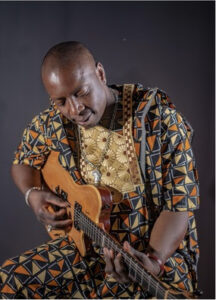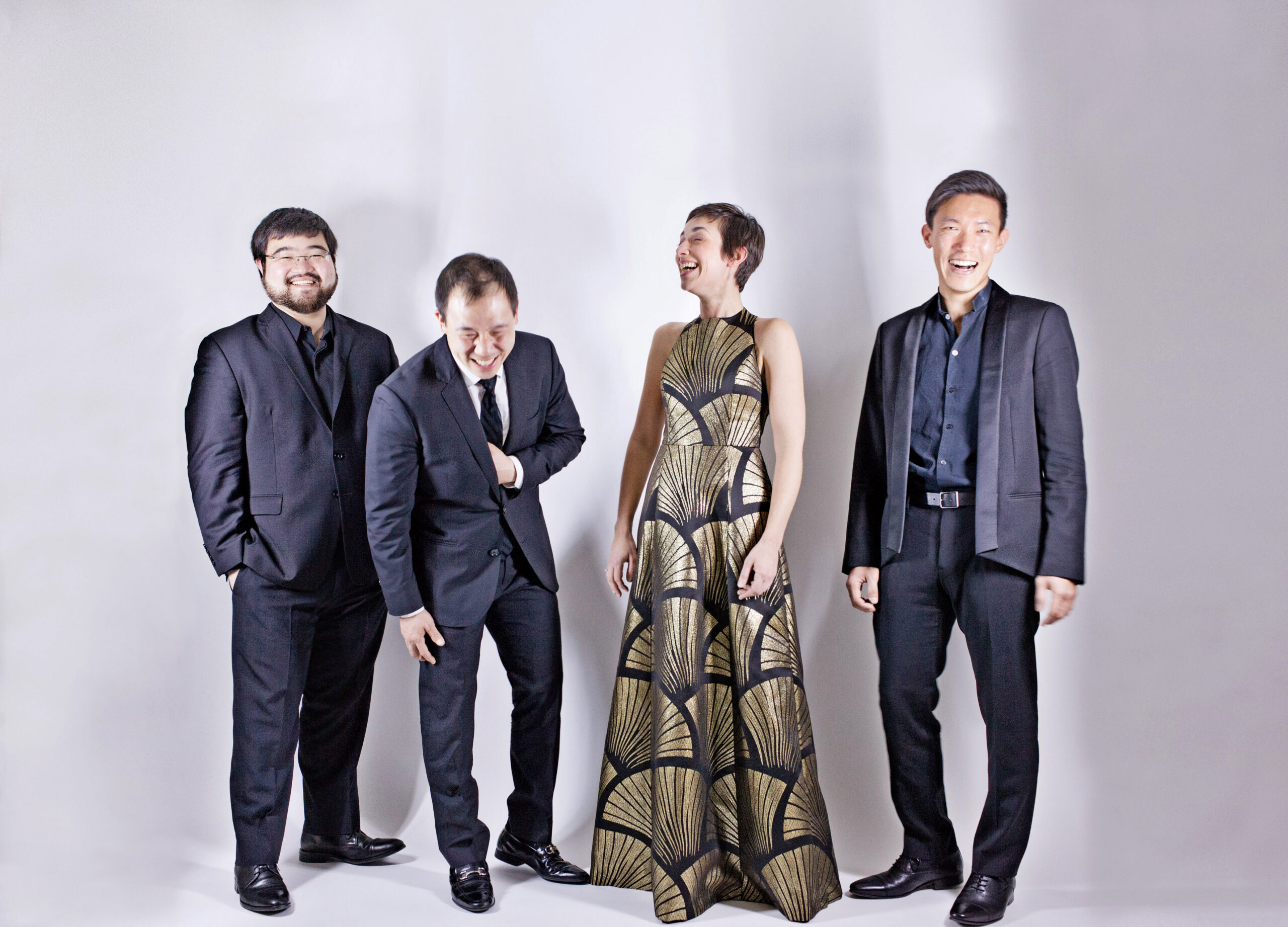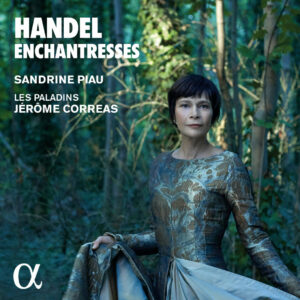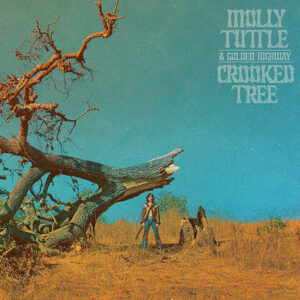On June 10, World Circuit will release Les Racines, an album by Malian guitarist Vieux Farka Touré.
The third single on the album, “Oglala Kaurene,” has been given video treatment. Check out Touré’s guitar stylings, which draw upon the work of previous Malian musicians while remaining distinctive in its deployment of punchy lines and looping polyrhythms. He isn’t known as “Hendrix of the Sahara” for nothing.
Touring
May 13—Freight & Salvage—Berkeley, CA
May 14—Center for the Arts—Grass Valley, CA
May 15—Felton Music Hall—Felton, CA
May 17—Musical Instrument Museum Theater—Phoenix, AZ
May 18—Dakota—Minneapolis, MN
May 19—SPACE—Evanston, IL
May 20—Le Poisson Rouge—New York, NY
May 21—World Café Live—Philadelphia, PA
May 22—Race Street Live—Holyoke, MA
June 8—Crystal Ballroom—Somerville, MA
June 10—Infinity Hall—Norfolk, CT
June 11—StageOne—Fairfield, CT
June 12—Afrika Nyaga Fest—Providence, RI
August 4—Celebrate Brooklyn—Brooklyn, NY
April the First proved a propitious date for the New York Classical Players’ much anticipated program featuring a new collaboration – and premiere – with the Parker Quartet. In the mere twelve years since their inception, NYCP has consistently brought spirit and devotion to so much of what they do, and this early Spring concert at W83 Auditorium was no exception. In many respects, the highlight of the evening was Jeremy Gill’s joyous new work, “Motherwhere,” a concerto grosso for the Parker Quartet and NYCP. But well-worn, oft’-loved music by Tchaikovsky was also on offer, delivered with great heart. And that is how the evening began:
Opening the program as soloist in the Andante Cantabile for cello and strings, Madeline Fayette, (NYCP’s own), commanded centerstage. Forthright, with an immediate brand of lyricism, Fayette radiated warmth from her cello, upheld by a muscularity of execution. Her global tone seemed born of a seductively dark palette. While lush and nourishing was Fayette’s romantic sense, the coloring became all too similar at times. One hankered for more variety in sonority, extracted from the piano end of the dynamic spectrum. Brighter hues too, would have enhanced an admittedly emotionally satisfying reading. Conductor Dongmin Kim guided the chamber orchestra deftly, ever sensitive to Fayette’s richly etched lines. Notably, Tchaikovsky’s moments of silence were realized expertly by Fayette, aided again by the orchestra’s soft touch. At times it seemed as though conductor Kim was a little too aloof and might well have taken opportunity to invigorate the proceedings with contrasting textures and inner accompaniment parts, especially from the upper strings.
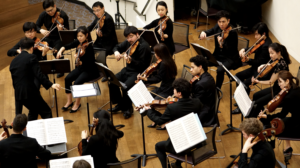
From the start, it was apparent that NYCP has an affinity for Tchaikovsky and such canonic works remain a hallmark of their repertoire. The second Tchaikovsky item on the program was the irresistible Serenade for Strings of 1880. It can easily be observed that the New York Classical Players straddle two worlds: that of a high-level ensemble who don’t really need a conductor, and that of the effortless sinfonietta who follow their leader with attentive skill and palpable delight. NYCP’s performance of the Serenade threw both spheres into sharp relief.
From the outset of Movement 1, this “Pezzo in forma di sonatina” bristled forth with an excess of springtide energy and conviction. Every single player was committed to the sum of the parts and proved adept at sweeping, upsprung passages. The full-blooded fortes were ever impressive, generous in their tonal production. The orchestra seemed less able to dig into the finer work of textural detail and soft timbres; refined aspects of blending were, at times, problematic. Nevertheless, moments of delicacy and whispered tunefulness were gloriously realized in the third movement, the Élégie.
In what has come to be earmarked as a personal work from Tchaikovsky, the Serenade’s folksy tendencies were cleverly enlightened by NYCP. At times, the spirit of Dvorak came to mind, as dance elements and rhythmic physicality were exemplified by the orchestra, flattering much of the performance. Kim’s conducting was precise and encouraging yet missed the larger picture. A “bird’s eye view” of this music would have been more satisfying.
A particularly memorable solo from the concert master nearly stole the show but it seemed to encourage the entire ensemble to really shoot for the top in the final movement, rhapsodically reaching every phrase with a breadth of expression. (This approach does prove effective – and often necessary! – in Tchaikovsky’s music.)
The evening’s premiere, Jeremy Gill’s Motherwhere, leapt to an earnest start, giving ample platform to the Parker Quartet’s myriad attributes. Vitality and playfulness abounded as this concerto grosso was set A-reveling, an ideal showcase for what the Parkers have become celebrated for. Characteristics of each of the four solo instruments (the concertino) bubbled happily to the fore, where divergent gestures narrated a candid mode of expression, integral and benevolent, perfectly suited to the musicians Gill so reveres. During a recent interview, the composer declared his affection for the Parker Quartet: “Writing for them is a joy, and I hope that joy is manifest in the notes I write for them.” He also emphasized his desire for “creating ideal environments in which ensembles can play and sound their best.” Motherwhere boasts eclectic source material, various in its own inspirations. Night School: A Reader for Grownups (2007) is a book of stories by author, Zsófia Bán. This was the starting point for Gill in an endeavor to “evoke, musically, the experience of reading her book.” The structure of Gill’s musical “metamorphosis” indicated itself, as he converted Bán’s “bag-of-tales” into a tightly wrought, nearly continuous set of twenty-one bagatelles. Self-proclaimed, this represents his objective to “match up the emotional evocations of the music and the tale.”
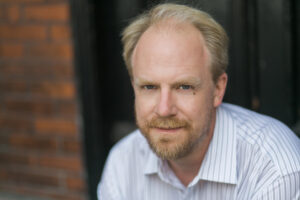
The Parker Quartet divine much from Gill’s 슬롯사이트 economy of means, transforming terse, even simple motives into a lingua franca for the listener to relish. Elements of familiarity are welcomed, as Gill’s sunny, near-hummable lines ring of truth and of beauty, distilled with a congenial dose of Americana. His carefully considered formal structures urge a dramatic, even theatrical, listening experience. Also finding folk aspects implicit to the string orchestra profile itself (cf. Tchaikovsky), Gill’s penchant for highlighting the concertino serves his purposes well; lower strings were especially punctuated. Some extended techniques proved effective throughout Motherwhere, often serving as percussive devices (ie. pizzicato, strumming and glissandi). The unison passages, while arresting, posed intonation challenges and became cumbersome, if not gritty.
Jeremy Gill’s vision of form, interaction and brightness of spirit must be thoroughly commended here. Through strength of artistic vision, technical expertise and familiarity with the commissioning ensemble, the composer has achieved a kind of cinematic, fictive musical world, jolly and inviting.
Equal enthusiasm for Zsófia Bán’s literary talent cannot be overstated. Indeed, her “bag-of-tales” might be requisite reading after this musical premiere. Bán herself mused on the “accidental encounter” that composer Gill had with her work. She likened it to “the clicking of two billiard balls on a global pool table.” And the entire performance at West 83rd Street, on this first April night in 2022, had that very air about it: a spirited, celebratory meeting of like-minded colleagues and friends. The specter of Antonio Vivaldi, with his ubiquitous provenance of “Spring,” saluted us too from on high.
NOTE: This concert review dates from a performance on Friday, April 1, 2022 at W83 Auditorium, New York
Handel: Enchantresses
Sandrine Piau, soprano
Les Paladins, Jérôme Correas, director
Alpha Classics
Soprano Sandrine Piau is a versatile artist who has compellingly performed a wide range of repertoire. Handel has remained a touchstone for Piau, and on Handel:Enchantresses, she explores a different subset of characters than the heroines and ingenues that were her bread and butter as a young singer. Handel is one of the great composers at illustrating grief, despair, and tempestuousness. The characters who inhabit these traits are given a showcase on this Alpha Classics CD.
Piau’s theatrical and expressive capabilities are on full display here. Rinaldo’s “Il Vostro Maggio,” a lament that is most touching, is delivered with considerable poignancy. Another lament, “Piangeró la Sorte Mia,” from Giulio Cesare in Egitto, alternates between aching appoggiaturas and a slow tempo in the outer sections and a middle section with fiery sixteenths. “Alla Salma Infedel,” from Lucrezia, is filled with closely spaced chromaticism, and Piau navigates her upper register with superlative control.
The soprano’s runs are fleet and clear, as evidenced on “Da Tempeste,” also from Guilio Cesare in Egitto, in which Cleopatra’s exults over her union with Julius Caesar. Sung with wide-ranging cadenzas and quickly rendered coloratura, this is tailor-made for Piau. “Scherza in mar la navicella,” from Lotario, is another showcase for fast-paced and wide-ranging singing that is as exciting as it is exactingly performed. “Ah! Mio cori,” from Alcina, is a riveting twelve-minute scena that features Piau’s singing at its most richly hued and dramatic.
Jérôme Correas leads Les Paladins with considerable flexibility, the ensemble turning on a dime to match Piau’s use of rubato. The instrumental pieces they present as interludes, excerpts from Concerto Grossos and the overture to Amadigi Di Gaulo, display Les Paladins to excellent advantage, playing nimble French overture rhythms in the overture and plangent dissonances in the G-minor concerto movement. They have a well balanced sound that is lustrous while being period-informed.
Some aria collections are grab bags or greatest hits recordings. Thoughtful curation is a welcome alternative that, happily, seems to have become more frequent. Handel: Enchantresses is ideal in this regard, in that it explores a different facet of Piau’s artistry while presenting arias that are, in many cases, underserved treasures. Highly recommended.
-Christian Carey

Magic&Unique Records has released Alien Music, a collection of the early works of Peter Thoegersen that combine alternate tuning with polytempic meters. With pieces dating from 2002, this album offers a baseline view of Thoegersen’s long-time exploration of the interrelationships between pitch and rhythm. As he writes in the liner notes: “Alien Music is essentially my first Polytempic Polymicrotonal piece composed from a four part drumset composition in four simultaneous meters/tempos: 3, 4, 5, 7, all played in one sitting. There are additional microtonal instruments added in different tunings: 12tet, 19tet, 7 tone slendro, and 5 tone pelog, tuned to parity with 7-limit just.”
The album consists of Alien Music and seven other tracks that incorporate a variety of experimental tunings, meters, different types of percussion, electronic sounds and even spoken phrases or chant. Thoegersen also includes original etudes and studies that reach back to the earliest realizations of his imaginative musical formulations. All the tracks on the album can be called alien in the sense that they sound otherworldly, but there is a double meaning in the album title: Thoegersen’s Polytempic Polymicrotonal music is also alien to all that has gone before it.
The title track, Alien Music, is perhaps the most developed piece of the collection. This opens with a steady percussive beat and an engaging microtonal melody in the marimba. Thoegersen’s crisp drumming weaves in and out of the texture, supported by an ambient wash in the deep background. The contrast of the frenetic drumming, cymbal crashes, marimba line and luminous bell tones with an undercurrent of languid strings is at once unsettling and engaging. The mixing is carefully crafted and does not unnecessarily favor any one element, allowing each to add to the total. The level of tension rises and falls as the piece proceeds, depending on what sounds are heard in the foreground. The active drumming subsides and then builds up in cycles and the ambient strings occasionally dominate to produce a mysterious feel. A nice groove develops in the percussion towards the finish and the piece ends with a soft bell tone that seems to hang in the air. For all its rhythmic and harmonic complexity, Alien Music holds together convincingly, with each unique element contributing to a cohesive and pleasing overall sound.
Other pieces on the album explore subsets of the polytempic and polymicrotonal possibilities that were incorporated into Alien Music. The shortest piece of the album is Polymicrotonality Etude VII, and this contains just an unintelligible echoed voice with bell microtones, one complimenting the other to create an increasingly anxious feel. Gorgeous Monstrosity, track 2, starts with a light tapping and scuffing, continually building to eventually include mechanical percussion and chimes. There is less integration of rhythm and pitch in this track but nevertheless it conveys a distinctively alien feel. Iraq, track 7, features more of Thoegersen’s solid drumming along with an almost conventional accompaniment of synthesized rock band and electronic keyboard. A sort of rough spoken rap is heard against a lyrical contrasting vocal line, and the ensemble works effectively to make a political statement critical of the invasion of Iraq. The other tracks of Alien Music are much like watching experiments in a laboratory, with each trying assess the potential of various combinations of ensemble, rhythm and tuning.
The impact of alternate tuning in contemporary music is still working itself out. Originally employed as a way to restore some character to the compromised conventional 12-tone equal temperament scale, alternate tuning has become a highly mathematical and theoretical discipline as well as an ongoing search for new harmonic syntax. Adding a polytempic component in addition to the microtone pitch set has been Thoegersen’s line of inquiry for over 20 years. His later works, such as Three Pieces in Polytempic Polymicrotonality from 2019, show a more mature handling of the polytempic polymicrotonal paradigm and are worth hearing for comparison. Alien Music provides a look into the origins of this system and gives us bright flashes of its future promise.
Alien Music is available for listening and download on Spotify.
Renowned bassist Jan Wobble (PIL) has joined with Ukrainian musicians to create a dub remix of the Ukrainian National Anthem. All proceeds will benefit Ukrainian Refugees. Please donate if you can.
LYRICS
Ukraine’s glory has not perished, nor her freedom gone
Our strong people, once again, fate will smile upon
All our enemies will soon disappear like dew in the sun
Then, once more will we be free, in the land we call our own
Body and soul we will lay down for our freedom
And the world will know that we are people of the Kozak nation
CREDITS
Produced by Jah Wobble and Jon Klein
Mixed and arranged by Jon Klein
Jah Wobble – bass
Jon Klein – guitar, keys and programming
‘The Legendary’ Len Liggins – lead vocal, backing vocal, violin
Peter Solowka – acoustic guitar, backing vocal
Paul Weatherhead – backing vocal, mandolin
Stephen ‘Mr Steff’ Tymruk – accordion
Jah Wobble cover photo by Paul Cliff
Video by Jon Klein and Rebecca Walkley; editing by Jon Klein
Molly Tuttle and Golden Highway
Crooked Tree
Nonesuch
Songwriter, vocalist, and guitarist Molly Tuttle makes her Nonesuch debut with Crooked Tree. Co-produced with dobro virtuoso Jerry Douglas, the release includes a number of prominent traditional musicians as collaborators and focuses on Tuttle’s connections to bluegrass and roots music. Previous releases have seen Tuttle sit astride pop and bluegrass, and while Crooked Tree emphasizes the latter, the memorability and single-worthy character of many of its songs reminds us that she is a versatile and formidable talent.
Tuttle plays guitar in a flat-picking style and at turns plays nimble lead lines and boisterous rhythm. A showcase for her playing is “Goodbye Girl.” On this track, as elsewhere, Douglas makes the perfect addition to the proceedings, seamlessly integrating his formidable chops into arrangements with Golden Highway. His solo on “Goodby Girl” is simultaneously fleet and soulful. Tuttle’s band Golden Highway, which consists of fiddle-player Bronwyn Keith-Hynes, mandolinist Dominick Leslie, banjo-player Kyle Tuttle, and bassist Shelby Means, are a formidable combination, all equally comfortable taking a solo turn as well as being imaginative yet rock solid ensemble players. Other musicians joined the sessions in Nashville, including bassist Viktor Krauss, drummer Jerry Pentecost, and harmonica-player Cory Younts. Ketch Secor co-writes several songs with Tuttle and contributes mandolin. Melody Walker is another co-writer and sings backing vocals on the album.
The title track starts with a slow build to the chorus, upon which we get the full band providing a vintage bluegrass arrangement, with a stirring fiddle solo from Keith-Hynes. “She’ll Change” and “Over the Line” show the assembled musicians to excellent advantage. Kyle Tuttle’s banjo takes the instrumental spotlight on “Flatland Girl,” while Margo Price contributes vocals. The layering of her voice with Tuttle creates a beautiful blend. Adding Old Crow Medicine Show to the “Big Backyard” creates another highlight focusing on group singing, a verse with a memorable hook followed by ebullient choruses. Guitarist and singer Billy Strings joins Tuttle on the blues shuffle “Dooley’s Farm.” The waltzing “San Francisco Blues” is a melancholy duet with Dan Tyminski. Perhaps the biggest star turn is Gillian Welch’s appearance on “Side Saddle,” a ribald, rousing showcase for the vocalists with great licks from Douglas.
Left to their own devices, Tuttle and Golden Highway provide equally compelling performances. “Nashville Mess Around” is great fun – a hootenanny, complete with yodeling. “The River Knows” has a haunting melody that alternates sparsely arranged accompaniment of the singing with intricate instrumental breaks.“Castilleja” co-opts the melody of “Poor Wayfarin’ Stranger,” but takes it uptempo. The album closes with a moving song, “Grass Valley,” which deals with family and loss with an uplifting sensibility. Crooked Tree is a compelling, uniformly excellent recording. Recommended.
-Christian Carey
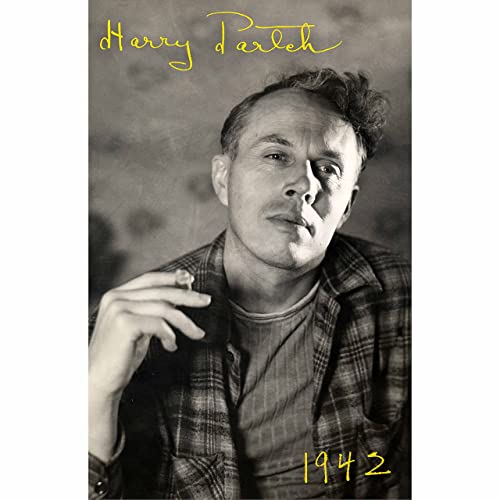
Harry Partch, 1942 is a combination CD and printed hardcover book from MicroFest Records that documents the events leading up to Partch’s pivotal recital in Kilbourn Hall at the Eastman School of Music on November 3, 1942. This proved to be the turning point in Partch’s career, after many years of frustration and hardship pursuing his innovative tuning theory. The CD contains the original recording of the recital and lecture at Kilbourn Hall and includes The Lord is My Shepherd, selections from Seventeen Lyrics by Li Po and the iconic Barstow. The book brings together notes, letters, newspaper accounts and Partch’s own artistic manifesto. When combined, his recorded words and music produce a deeper appreciation of this immensely influential composer.
Those who follow new music at some point become aware of Harry Partch as a pioneer of alternate tuning theory and the creator of handmade acoustic instruments. We have likely heard a performance of the popular Barstow and formed a rather hazy image of Partch as a luckless vagabond toiling away in obscurity. While all this is partly true, Harry Partch, 1942 provides a wealth of material that illuminates an active and highly developed intellect that will cause even the most doubtful listener to reconsider the value of his work.
In the center of the book is a reproduced copy of Partch’s hand-typed resume: “The Music Philosophy and Work of Harry Partch Composer – Instrument Builder and Player – Theorist.” This occupies a dozen pages and includes sections on his music theory and system, notation, his instruments and a personal biography. This alone makes Harry Partch, 1942 worth owning. The biography is especially revealing and describes his early interest in the science of wave theory – especially the Helmholtz-Ellis book Sensations of Tone. This resulted in the conviction that conventional music lacked ‘true intervals’ and the remedy Partch proposed was a tuning system that contained no less than 43 divisions of the octave. He soon began building several specialized musical instruments designed to achieve this. The book also describes how Partch continued his private research in the British Museum in London, studying Greek and other historical tuning systems. A visit with W.B. Yeats in Dublin evolved into the theory of ‘speech music’; the idea that music should contain the inflections and rhythmic patterns that give human speech its emotional power. The depth and discipline of Partch’s self-directed study is astonishing.
Harry Partch, 1942 also describes the difficulties he endured during his long struggle to advance his unique musical vision. Partch worked for a time in the proofing rooms of various California newspapers as well as other odd jobs to support his art. Always short of funds, he nevertheless continued to experiment with tuning and the construction his instruments. He was, as he described in his biography, “…beginning to retrace the whole history of the theory of music.” When the ‘adapted viola’ was completed Partch gave countless demonstrations and networked among local California musicians and music patrons. He applied for, and was awarded, a Carnegie Grant of $1500 that allowed him to travel to England to further his research. Upon his return he lived in a small cabin in Carmel, CA to further refine his new instruments. Eventually Partch built the viola, two reed organs, a kitharn and the adapted guitar. As compiled by John Schneider, the liner notes and text in Harry Partch, 1942 covers all of this in detail, without being tedious or boring.
The book also describes Partch’s 1941 epiphany in Carmel, the legendary two-week hitch-hiking journey to Chicago and his efforts there to promote his music. Famously, Partch arrived in Chicago with just ten cents in his pocket but soon embarked on a series of undesirable jobs while supporting his music. There is a copy of a November, 1941 concert bill at the Chicago School of Design, where Partch performed, that also included works by John Cage and Lou Harrison. The book also has copies of the letters that Partch wrote to various new music luminaries to solicit support, and these efforts ultimately gained him an invitation from Howard Hanson to lecture and perform at the Eastman School the following year. Harry Partch, 1942 carefully lays out the sequence of circumstances that led up to this decisive moment in his career.
The CD included with the book was crafted from the original recording of his appearance in Kilbourn Hall. The CD is divided up into 16 separate tracks, each containing a distinctive element of the lecture. The first thing you notice is that, although not studio perfect, the quality is surprisingly good given the technology of the early recording machines in use at the time. Scott Fraser’s restoration work here is especially noteworthy. Partch’s lecturing is also remarkable in that he is articulate, thoughtful and always in full command of his subject. The explanations and demonstrations of his tuning scheme and instruments are full of technical detail, yet concise and eloquent. His engagement with the student audience is notable, especially with his singing and sly humor. No doubt Partch had much previous experience presenting his ideas, but his delivery in this recording is polished and a pleasure to hear.
In the CD, Partch describes and then demonstrates his speech music technique with The Lord is My Shepherd (23d Psalm), sung and accompanied by the composer playing the chromolodian. The adapted viola is introduced and then used to accompany several of the Seventeen Lyrics by Li Po. This proves to be a more effective demonstration with the exotic drama of the English translation nicely complimented by the timbre and diverse pitch set of the viola. An enthusiastic ovation follows, doubtless inspired by Partch’s masterful playing as the vocals are clearly heard working in tandem with the expressive lyrics. Far from his reputation as the rumpled vagabond, Partch here shows himself to be a first-rate performer.
The final sections of the CD are devoted to Barstow, with Partch describing his adapted guitar along with the background and origins of this enduring work. As Barstow is speech music, based on the interaction between the singing voice and accompaniment, we have in this fine recording the definitive performance by it’s talented composer.
Harry Partch, 1942 is a brilliantly organized portrait of the events in a critical year for Harry Partch – and for new music in general. This handsome book, with its meticulously engineered CD, belongs on the bookshelf of anyone who is studying or working in alternate tuning.
Harry Partch, 1942 is available from MicroFest Records and Amazon.
Wolfgang Rihm
Jagden und Formen
Bavarian Radio Orchestra, Franck Ollu, conductor
BR-Klassik CD
Wolfgang Rihm’s hour long orchestra work Jagden und Formen (2008) has its roots in an earlier work, some fifteen minutes long, from 1996, dedicated to Helmut Lachenmann on his sixtieth birthday. The piece ultimately morphed and expanded into the version recorded here. There is precedence for this in postwar Europe, particularly in several of the works of Pierre Boulez, which remained in progress and perpetually expanding throughout his lifetime. In his program note, Rihm says that the piece will henceforth likely remain in its current form.
While it is dedicated to Lachenmann, the piece remains solidly in Rihm’s language. The music is muscular, post-tonal, and replete with strongly articulated gestures. At the same time, there are guideposts that afford the listener a sense of groundedness: returning sections, repeated pitches that provide momentary centers, and phrase boundaries that include landing points akin to cadences.
The piece’s scoring is somewhat unusual. Winds are doubled, but strings are one to a part, the result being a kind of sinfonietta with bolstered textures. The choice for solo strings is canny, in that Rihm frequently deploys them like a chamber quintet within the whole ensemble. The extraordinary tone of the Bavarian Radio Orchestra’s strings undoubtedly abets this impression. This is equally true of the rest of the ensemble, which frequently creates glistening textures and just as often fluid counterpoint that ricochets between instrumental cohorts.
The recording is broken up into tracks, but these do not demarcate movements. They connote sections with particular tempos and scoring, and so suggest the overall formal trajectory of the piece. Adding to the aforementioned concertino impression are a number of solo turns. Particularly impressive are the blindingly fast runs by pitched percussion and the equally fast angular solos taken by the oboe and bassoon. Jagden und Formen traverses a number of tempos, and it is to Franck Ollu’s credit that transitions are seamlessly negotiated and even the most breathless passages are well-coordinated. The piece’s abundant variety and compelling sound world make it a solid addition to Rihm’s compendious catalog. Jagden und Formen will likely see more performances, but this recording will long remain a benchmark.
-Christian Carey
Interialcell
Aleksandra Gryka
Florian Müller, harpsichord; Klangforum Wien, Joseph Kalitzke, conductor
Kairos CD
Klangforum Wien is undertaking a series of portrait recordings on Kairos of Polish composers. The first solo CD of music by Aleksandra Gyrka (b. 1977), Interialcell, is an impressive introduction to this composer. Consisting of ensemble pieces written from 2003 to 2015, Interialcell provides a sense of the maturation of an already talented composer in her late twenties to work that takes on successively more intricate materials and formal designs in her thirties.
Regarding the impetus for her music, Gryka is fairly secretive. The hard sciences, particularly quantum physics, are mentioned frequently as a reference point, as are cosmology and sci-fi. A number of her works deal with uncomfortable emotions in extremis, notably the theatre works Scream You! and Our Hell and incidental music for several plays. The instrumental pieces on Interialcell may not have a narrative component that is specifically locatable, but they clearly are wrought from the same combination of scientific, theatrical, and fantastical elements, melding together a panoply of musical elements to provide a sense of this inspirational diversity.
Youmec is a work for harpsichord and ensemble. Florian Müller is frequently called upon to play clustered verticals as well as enigmatic ostinatos. These are accompanied by undulating glissandos in the ensemble. In a sense, the texture is an inversion of the usual concertino. The soloist plays chords while the group is afforded gestural writing. At the piece’s climax, the ensemble begins to ricochet its own vertical off of the solo’s repeated chords.
Interialcell opens with thrumming timpani and angular melodic cells in the strings alongside fast chromatic runs in the piano and pitched percussion. The accents of the cells become a grid for rhythmic transformations in a number of scorings and dynamic levels; a deft structural design. Emtyloop begins with furious, corruscating, overlapping strings. This idea of overlapping ostinatos is explored throughout the piece, with hairpin dynamics creating swooning contrasts. Particularly affecting is the later overlap in the upper “dolphin call” register, supplanted by cello glissandos. einerjedeneither juxtaposes percussion pulsations with chromatic wind lines, spectral verticals, and frequent silences. Instruments blown through, aphoristic piano gestures, and microtonal bends complete a haunting, gradually unfolding environment.
Mutedisorder closes out the album with furtive, hushed gestures in a portentous ambience. It is somewhat reminiscent of Mark André’s recent works exploring pianissimo. Gryka demonstrates command over the wide range of materials she selects and a special ear for timbre. Recommended.
-Christian Carey

